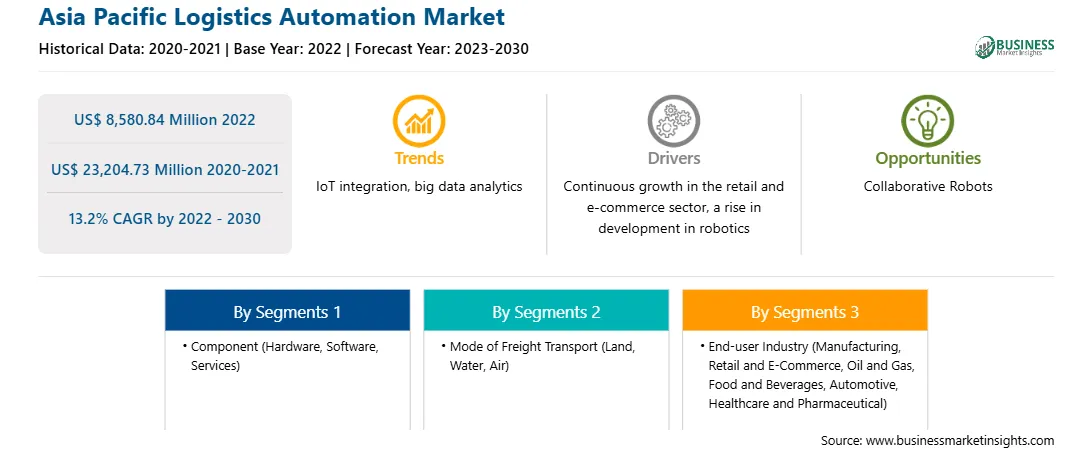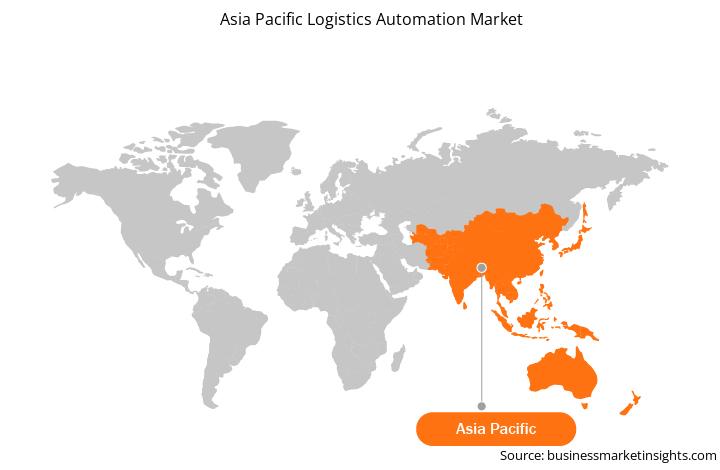亚太物流自动化市场预测至 2030 年 - 区域分析 - 按组件(硬件、软件和服务)、货运方式(陆运、水运和空运)、应用(仓库管理和运输管理)、最终用户行业(制造业、零售业和电子商务、石油和天然气、食品和饮料、汽车、医疗保健和制药等)
No. of Pages: 118 | Report Code: BMIRE00030370 | Category: Electronics and Semiconductor
No. of Pages: 118 | Report Code: BMIRE00030370 | Category: Electronics and Semiconductor
Strategic insights for Asia Pacific Logistics Automation involve closely monitoring industry trends, consumer behaviours, and competitor actions to identify opportunities for growth. By leveraging data analytics, businesses can anticipate market shifts and make informed decisions that align with evolving customer needs. Understanding these dynamics helps companies adjust their strategies proactively, enhance customer engagement, and strengthen their competitive edge. Building strong relationships with stakeholders and staying agile in response to changes ensures long-term success in any market.

| Report Attribute | Details |
|---|---|
| Market size in 2022 | US$ 8,580.84 Million |
| Market Size by 2030 | US$ 23,204.73 Million |
| Global CAGR (2022 - 2030) | 13.2% |
| Historical Data | 2020-2021 |
| Forecast period | 2023-2030 |
| Segments Covered |
By 组件
|
| Regions and Countries Covered | 亚太地区
|
| Market leaders and key company profiles |
The regional scope of Asia Pacific Logistics Automation refers to the geographical area in which a business operates and competes. Understanding regional nuances, such as local consumer preferences, economic conditions, and regulatory environments, is crucial for tailoring strategies to specific markets. Businesses can expand their reach by identifying underserved regions or adapting their offerings to meet regional demands. A clear regional focus allows for more effective resource allocation, targeted marketing, and better positioning against local competitors, ultimately driving growth in those specific areas.

1. BEUMER Group GmbH & co KG
2. Daifuku Co Ltd
3. Dematic Corp
4. Honeywell Intonational Inc
5. KNAPP AG
6. Murata Machinery Ltd
7. Swisslog Holding AG
8. TGW Logistics Group GmbH
9. Toshiba Infrastructure Systems and Solutions Corp
The Asia Pacific Logistics Automation Market is valued at US$ 8,580.84 Million in 2022, it is projected to reach US$ 23,204.73 Million by 2030.
As per our report Asia Pacific Logistics Automation Market, the market size is valued at US$ 8,580.84 Million in 2022, projecting it to reach US$ 23,204.73 Million by 2030. This translates to a CAGR of approximately 13.2% during the forecast period.
The Asia Pacific Logistics Automation Market report typically cover these key segments-
The historic period, base year, and forecast period can vary slightly depending on the specific market research report. However, for the Asia Pacific Logistics Automation Market report:
The Asia Pacific Logistics Automation Market is populated by several key players, each contributing to its growth and innovation. Some of the major players include:
The Asia Pacific Logistics Automation Market report is valuable for diverse stakeholders, including:
Essentially, anyone involved in or considering involvement in the Asia Pacific Logistics Automation Market value chain can benefit from the information contained in a comprehensive market report.